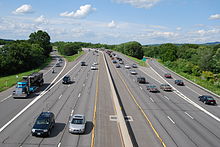- Diamond interchange
-
A diamond interchange is a common type of road junction, used where a freeway crosses a minor road. The freeway itself is grade-separated from the minor road, one crossing the other over a bridge. Approaching the interchange from either direction, an off-ramp diverges only slightly from the freeway and runs directly across the minor road, becoming an on-ramp that returns to the freeway in similar fashion.
The two places where the ramps meet the road are treated as conventional intersections. In the United States, where this form of interchange is very common, particularly in rural areas, traffic on the off-ramp typically faces a stop sign at the minor road, while traffic turning onto the freeway is unrestricted.
The diamond interchange uses less space than most types of freeway interchange, and avoids the interweaving traffic flows that occur in interchanges such as the cloverleaf. Thus, diamond interchanges are most effective in areas where traffic is light and a more expensive interchange type is not needed. But where traffic volumes are higher, the two intersections within the interchange often feature additional traffic control measures such as traffic lights and extra lanes dedicated to turning traffic.
The ramp intersections may also be configured as a pair of roundabouts to create a type of diamond interchange often called a dumbbell interchange. Because roundabouts can generally handle traffic with fewer approach lanes than other intersection types, interchange construction costs can be reduced by eliminating the need for a wider bridge. This type of interchange is common in the United Kingdom and Ireland, and is becoming increasingly common in the United States. Examples of dumbbell interchanges within the United States are located on Interstate 35 in Medford, Minnesota, on Interstate 70 in Avon, Colorado, on Interstate 87 in Malta, New York, and on Interstate 17 at Happy Valley Road north of Phoenix, Arizona.
Where HOV lanes are present for carpooling, the ramps of a diamond interchange may be folded to the inside lanes instead of the outside. In urban areas this saves some space as well as requiring only one intersection instead of the two one-way intersections, which in rural or suburban areas can be turned into a single-point urban interchange. This in turn reduces waiting time for motorists at traffic lights on the smaller road, which may be a large local thoroughfare with heavy traffic.
See also
Roads and junctions Types of road By countryGermany · Croatia · Spain · Italy · Portugal · Czech Republic · Ireland · United States (U.S. Routes · Interstates)Main roadsArterial road · Collector road · Express-collector setup · Farm-to-market road · Highway · Link road · Two-lane expressway · 2+1 road (Parkway · Super two · 2+2 road) · Trunk road · Highway systems by countryLocal roadsBoulevard · Frontage road · Road · Single carriageway · Street · Alley · Backroad · Cul-de-sac · Driveway · Lane · Primitive road · Side roadOther termsSurfaces Asphalt concrete · Brick · Chipseal · Cobblestone · Concrete · Corduroy · Dirt · Gravel · Ice · Macadam · Oiled (bitumen) · Plank · Sett · TarmacRoad junctions Cloverleaf · Diamond · Directional T · Diverging diamond · Parclo · Trumpet · SPUI · Stack · Three-level diamond · Raindrop · Roundabout interchangeCategories:- Road junction types
Wikimedia Foundation. 2010.



